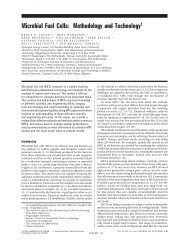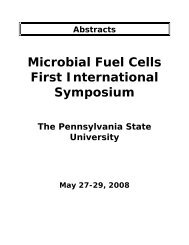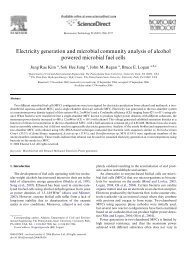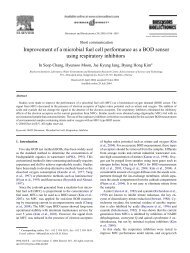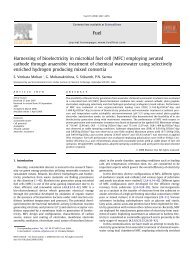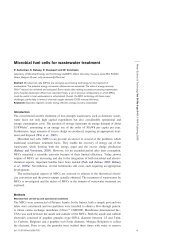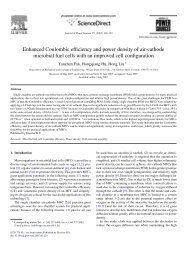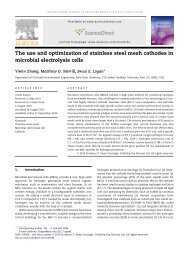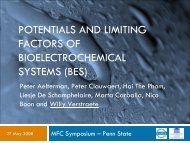Power from marine sediment fuel cells: the influence of anode material
Power from marine sediment fuel cells: the influence of anode material
Power from marine sediment fuel cells: the influence of anode material
You also want an ePaper? Increase the reach of your titles
YUMPU automatically turns print PDFs into web optimized ePapers that Google loves.
J Appl Electrochem (2008) 38:1313–1319 1315<br />
producing low levels <strong>of</strong> power. The <strong>material</strong>s used were<br />
restricted to a selection <strong>of</strong> carbon <strong>material</strong>s with relatively<br />
high surface areas and which were not chemically modified;<br />
in an attempt to maintain long term operation.<br />
2 Experimental<br />
2.1 Microbial <strong>fuel</strong> cell<br />
Figure 1 shows a schematic <strong>of</strong> <strong>the</strong> MFC, which consisted<br />
<strong>of</strong> an inert cylindrical container, 16 cm in diameter and<br />
16 cm high. The <strong>anode</strong> was 11 cm in diameter, and was<br />
buried 3 cm below and parallel to <strong>the</strong> surface <strong>of</strong> <strong>the</strong> <strong>sediment</strong>.<br />
The cathode, 15 cm in diameter, was positioned in<br />
<strong>the</strong> seawater, 2–3 cm above and parallel to <strong>the</strong> <strong>sediment</strong><br />
surface. The seawater layer above <strong>the</strong> cathode was 5 cm in<br />
depth. No separator was used in <strong>the</strong> cell. Air supply to <strong>the</strong><br />
cathode was thus by natural diffusion <strong>from</strong> <strong>the</strong> surface <strong>of</strong><br />
<strong>the</strong> seawater unless o<strong>the</strong>rwise stated.<br />
The <strong>anode</strong> and cathode were supported by plastic rings<br />
to maintain <strong>the</strong>ir horizontal positions. The <strong>fuel</strong> <strong>cells</strong> were<br />
maintained at room temperature except when <strong>the</strong> effect <strong>of</strong><br />
temperature was investigated. Cells using different <strong>anode</strong>s<br />
were tested, in duplicate and simultaneously, using <strong>the</strong><br />
same sources <strong>of</strong> <strong>sediment</strong> and seawater, over <strong>the</strong> period <strong>of</strong><br />
<strong>the</strong> study, which for some <strong>cells</strong> was 9 months.<br />
Silver chloride references electrodes were connected to<br />
<strong>the</strong> <strong>cells</strong>, via luggin capillary probes, to measure electrode<br />
potentials. Current densities quoted in this paper are based<br />
on <strong>the</strong> <strong>anode</strong> cross sectional area.<br />
The <strong>marine</strong> <strong>sediment</strong> and seawater were collected <strong>from</strong><br />
<strong>the</strong> North Sea, <strong>of</strong>f <strong>the</strong> north-east coast <strong>of</strong> England<br />
(55°01 0 08 00 N, 1°25 0 11 00 W) at a depth <strong>of</strong> 62 m. The<br />
<strong>material</strong>s were transported under reduced temperature to<br />
restrict microbial growth, to nearby laboratory facilities<br />
As part <strong>of</strong> <strong>the</strong> test protocol, <strong>the</strong> <strong>cells</strong> were initially left to<br />
equilibrate, while monitoring <strong>the</strong> open circuit voltage<br />
(OCV). When <strong>the</strong> OCV stabilised, an external circuit was<br />
established, with electrodes connected through a variable<br />
resistor load, using ei<strong>the</strong>r a DC power supply or a variable<br />
resistor. The variable resistor was used to generate cell<br />
current density and voltage polarization data. Current<br />
generated across <strong>the</strong> cell, <strong>of</strong> <strong>the</strong> order <strong>of</strong> microamps, was<br />
measured using a multimeter, while continually monitoring<br />
<strong>the</strong> voltage via a second multimeter. O<strong>the</strong>r parameters<br />
monitored were, electrode potentials, pH, and dissolved<br />
oxygen (YSI 550A dissolved oxygen meter) in <strong>the</strong> water<br />
and in <strong>the</strong> <strong>sediment</strong>.<br />
2.1.1 Electrodes<br />
Anodes used in this study were all carbon and were<br />
selected because <strong>of</strong> <strong>the</strong>ir different characteristics (porosity,<br />
morphology, carbon type). The <strong>material</strong>s used were carbon<br />
cloth (Avcarb 1209 HC, Ballard), carbon paper (Toray<br />
Carbon Paper TGP60 0WP), carbon sponge, graphite<br />
(5 mm thick disk) and reticulated vitreous carbon (RVC).<br />
The RVC <strong>anode</strong> was 1.2 cm thick, 100 ppi (nominal pores<br />
per linear inch) grade. RVC is a porous, rigid <strong>material</strong> with<br />
an open structure and good electrical conductivity. Electrodes<br />
were pre-treated before use, by washing in acetone<br />
for 15 min, followed by boiling in 1.0 mol dm -3 (M) HCl<br />
for 15 min and <strong>the</strong>n rinsing in de-ionised water.<br />
The cathode used in all <strong>cells</strong> was carbon cloth. Silver<br />
chloride references electrodes connected to <strong>the</strong> cathodes<br />
using luggin capillary probes were used to measure electrode<br />
potentials.<br />
H 2 O<br />
O 2<br />
Cathode<br />
Ref.<br />
Electrode<br />
3 Results and discussion<br />
3.1 Performance <strong>of</strong> <strong>the</strong> <strong>sediment</strong> <strong>fuel</strong> cell<br />
Seawater<br />
Sediment<br />
H +<br />
Anode<br />
Anode<br />
x red x ox Microbes<br />
CO 2<br />
(CH C2 H4O<br />
2 O)<br />
x<br />
Load<br />
Voltmete<br />
y<br />
Ammeter<br />
Fig. 1 Schematic representation <strong>of</strong> <strong>the</strong> <strong>sediment</strong> microbial <strong>fuel</strong> cell<br />
e -<br />
At <strong>the</strong> beginning <strong>of</strong> <strong>the</strong> tests, <strong>the</strong> <strong>fuel</strong> <strong>cells</strong> were left to run<br />
at open circuit to allow bacterial colonisation <strong>of</strong> <strong>the</strong> <strong>anode</strong><br />
and cathode. The voltage <strong>of</strong> each MFC was monitored<br />
daily, until it reached equilibrium, which suggested that <strong>the</strong><br />
<strong>anode</strong> had been colonized by a ‘‘stable’’ bacterial community.<br />
The MFCs needed several weeks to equilibrate<br />
until <strong>the</strong> <strong>anode</strong>s were colonised by <strong>the</strong> bacterial population<br />
<strong>from</strong> <strong>the</strong> <strong>marine</strong> <strong>sediment</strong>. The equilibration period <strong>of</strong> <strong>the</strong><br />
<strong>cells</strong>, i.e. <strong>the</strong> time to reach a relatively stable potential,<br />
varied with <strong>the</strong> electrode <strong>material</strong>s used; this fact can be<br />
attributed to <strong>the</strong> different morphologies, structure and<br />
surface characteristics <strong>of</strong> <strong>the</strong> electrode <strong>material</strong>s and<br />
potential ‘‘biocompatibility’’ with <strong>the</strong> bacterial populations<br />
123



